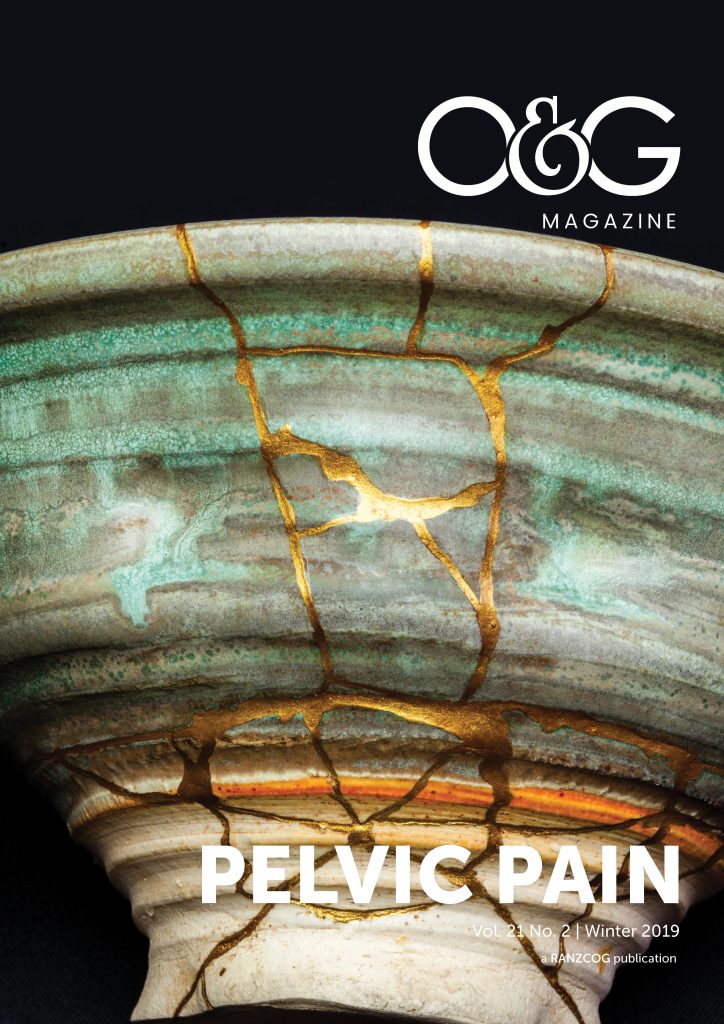Interventions are a small, but important, component of pain management. Recognition of interdisciplinary management and the role of intervention as part of a sociopsychobiomedical paradigm of care is necessary before undertaking procedures. The management of pelvic pain should not be confined to a Cartesian model of practice, where pain is viewed as a symptom and treatment is directed to an identified cause. Pain management targets the mechanisms of pain and the goals of treatment are to improve patient quality of life and function in concordance with patient-defined goals.1
Gynaecologists and obstetricians have a unique role in managing pelvic pain because of their understanding of women’s broader quality of life outcomes and goals that come with experiencing pelvic pain. These include sexual health, fertility and pregnancy, and bladder and bowel function.
Pain management in our specialty is not restricted to caring for women with endometriosis (Table 1). A pelvic pain service should offer support for women with any pain, collaborate with our anaesthetic and palliative care colleagues, and has a unique opportunity to address pain as it intersects with changes in a woman’s life.
Table 1. Typical consultations of a pelvic pain service.
| Gynaecology | Persistent pelvic pain Dyspareunia Levator myalgia Peripheral neuralgias (including pudendal, iliohypogastric) Chronic post-surgical pain (including mesh related pain) Bladder pain syndrome Visceral hyperalgesia Migraine |
| Obstetric | Chronic pain conditions in pregnancy including rheumatoid arthritis, SLE, Ehlers-Danlos, CRPS Opioid use in pregnancy Pelvic girdle pain Coccydynia Obstetric trauma and pudendal neuralgia Chronic pain after LSCS |
| Acute pain | Preventive analgesia Management of opioid-dependent patients |
| Cancer pain | Sexual dysfunction and pain Interventional management (including nerve blocks, intrathecal therapy) |
| Education | Patient – individual and group Primary health College |
Accordingly, there is a breadth of indications for interventions in the management of pelvic pain. Some of the more common interventions are outlined in this article.
Botulinum toxin to the pelvic floor
Women with pelvic floor myalgia may benefit from botulinum toxin.2 Pelvic floor myalgia arises from dysfunction in muscle and the surrounding connective tissue. It presents commonly in women with persistent pelvic pain and can be associated with endometriosis, bladder pain syndromes, vulvodynia and irritable bowel syndrome. Management is interdisciplinary and includes patient education, physical therapy, psychology and pharmacotherapy for neuropathic pain.
Women with pain refractory to these measures may be offered botulinum toxin to pelvic muscles. Botulinum toxin engenders antidystonic effects by inhibiting acetylcholine release at the neuromuscular junction. It may also have actions on afferent signalling and nociception via blockade of substance P and glutamate. Onset of action begins to occur in two to five days and reaches its nadir after two weeks. The duration of action reduces after three months.
The clinical potential of botulinum toxin has long been recognised from the 19th century, when Justinus Kerner studied the toxin from sausage poisoning on animals and, ultimately, himself.3 Botulinum toxin is utilised widely for spasticity, dystonia, migraine and overactive bladder. Botulinum toxin to the pelvic floor can reduce dyspareunia, non-menstrual pelvic pain and vaginal pelvic floor pressures. Lower doses applied to select muscles, such as bulbospongiosus, were not found to be effective.
It is prudent to note that the application of botulinum toxin is directed to the muscle and is distinct from trigger point injection. It is not clear that the use of botulinum toxin, local anaesthetic, saline or physical therapy are superior to each other in trigger point treatment. The concept of trigger points in clinical practice has also been challenged, as trigger points may be a manifestation of altered central nociceptive mechanisms, rather than a generator of pain of itself.4
Pudendal block
Pudendal blocks are part of the diagnostic criteria for pudendal nerve entrapment syndrome and may be therapeutic in a subset of women with pudendal neuralgia. Women with pudendal neuralgia present with pain in the distribution of the nerve, which may include the clitoris, vagina and anus. Pudendal nerve entrapment syndrome, one type of presentation of pudendal neuralgia, is defined by Nantes criteria (Box 1).5 When pain is relieved at pudendal block, even temporarily, the block is considered positive. Pudendal blocks are best undertaken from a transgluteal route, with the needle directed under radiological guidance to the space between the sacrotuberous and sacrospinous ligaments. A transgluteal approach is more likely to target the anatomical site of entrapment between these ligaments and block early branching of the pudendal nerve, which can occur above the ischial spine. This approach is more proximal than the vaginal approach, which blocks the nerve in Alcock’s canal.
Pain in the distribution of the pudendal nerve
Pain worse on sitting
Pain does not wake at night
No objective sensory deficit features
Positive response to a pudendal block
The addition of steroids is not helpful to the therapeutic effect of the block.6 A minority of patients derive therapeutic benefit from a local anaesthetic block alone. The addition of other agents or the use of pulsed radiofrequency are being investigated. Older women and women who have subacute pudendal neuralgia after an event such as birth or surgery are most likely to derive therapeutic benefit.
Sympathetic blocks
Sympathetic blocks include superior hypogastric blocks and blocks to the impar ganglion. These blocks are typically undertaken in the prone position under radiological guidance. For superior hypogastric blocks, a long spinal needle is directed in a paravertebral direction to lie anterolateral to L5/S1. The impar ganglion can be accessed through a coccygeal junction, or anterior and cephalad from the tip of the coccyx, or through a paravertebral approach.
Superior hypogastric blocks have been described in cohort studies and case series, particularly in the setting of persistent pain in malignancy. Their benefit in chronic non-cancer pain is select given that visceral nociception is not defined by a single neuroanatomical pathway and that central pain mechanisms tend to be involved in visceral hyperalgesia. Patients with cancer pain undergo a diagnostic block with local anaesthetic, and if they derive improvement, then an ablation with phenol, alcohol or radiofrequency is undertaken.
The impar ganglion is the coalescence of the paravertebral sympathetic chains at the anterior surface of the coccyx. Visceral afferent fibres from the rectum travel with sympathetic fibres. Some women with coccydynia may benefit from radiofrequency treatment to the impar ganglion. Coccyx pain has mixed mechanisms, however, including from coccyx trauma, ligaments, levators and somatic innervation from the sacral plexus and women should be offered non-interventional management first.
Sacroiliac blocks
Pain derived from the sacroiliac joint may present with low back pain or posterior pelvic pain. It can be associated with joint inflammation in rheumatological diseases or with joint and ligamentous dysfunction, such as during and after pregnancy, or in connective tissue disorders. In the setting of pregnancy, exercise and physical therapy are most commonly used.
A minority of women with persistent pain may benefit from sacroiliac joint injections. Bipolar and monopolar radiofrequency ablation of the lateral sacral branches has been described, but most presentations are for back pain and to a pain clinic. Platelet-rich plasma applied to the sacroiliac ligaments is being investigated and may be an option for women with continued dysfunction or laxity despite conservative measures.
Sacral and pudendal neuromodulation
Neuromodulation is a promising avenue of management for well selected patients. Sacral neurostimulation is familiar to gynaecologists and is a well-established intervention for bladder dysfunction with leads directed to the S3 nerve root. The Sydney protocol described by Thierry Vancaillie treats pain and organ dysfunction using multiple leads, multiple waveforms and a combination of waveforms.7
Leads are typically placed via the sacral hiatus over the sacral dorsal root ganglia, through the S3 or S4 foramina or may include peripheral stimulation of the pudendal nerve. Mechanisms of action include altering the excitability of cells in the dorsal root ganglia involved in nociception, inhibition of wide dynamic range neurons through GABAergic or other mechanisms and possibly through effects on the brainstem and limbic system. This addresses several mechanisms of pain, including central mechanisms, with the dorsal root ganglia an important target.
Other techniques and targets have been described. Pudendal neuromodulation alone may be a treatment option for persistent genital arousal disorder. Conus medullaris stimulation for pudendal neuralgia has been described for patients who have failed pudendal decompression surgery. A retrograde approach to lead insertion has also been described, but is technically difficult and not widely applied.
Conclusion
The outlined interventions are helpful for well-selected patients and may be offered as part of interdisciplinary management for the woman with persistent pelvic pain. Patients may disengage or be caused psychological distress if an intervention first approach is applied, or if surgery or intervention is used as the triage to interdisciplinary management. An evaluation of the patient’s functional goals and mechanisms for pain in a sociopsychobiomedical context is essential.
References
- PJ Siddall, MJ Cousins. Persistent pain as a disease entity: implications for clinical management. Anesth Analg. 2004;99:510-20.
- JA Abbott, SK Jarvis, SD Lyons, et al. Botulinum toxin type A for chronic pain and pelvic floor spasm in women. Obstetrics and Gynecology. 2006;108(4):915-23.
- FJ Ergbuth, M Naumann. Historical aspects of botulinum toxin. Neurology. 1999; 53(8):1850-3.
- JL Quintner, GM Bove, ML Cohen. A critical evaluation of the trigger point phenomenon. Rheumatology. 2015;54(3):392-9.
- J-J Labat, T Riant, R Robert, et al. Diagnostic criteria for pudendal neuralgia by pudendal nerve entrapment (Nantes critera). Neurourol Urodyn. 2008;27(4):306-10.
- J-J Labat, T Riant, A Lassaux, et al. Adding corticosteroids to the pudendal nerve block for pudendal neuralgia. BJOG. 2017;124(2):251-60.
- T Vancaillie, L Kite, E Howard, et al. Sacral neuromodulation for pelvic pain and pelvic organ dysfunction. ANZJOG. 2018;58(1):102-7.






I am an administrator with a worldwide ‘secret’ facebook support group for people suffering PGAD. We are always looking for Doctors who have an understanding of this condition so we can suggest them to our members in an attempt to stop them having to go through the ‘trial and error’ frustration of seeing medicos who have no knowledge of this debilitating condition. We have nearly 500 members with the numbers in Australia quickly growing but very few places that we can suggest. Does Dr Chow know of this condition and is he willing to have his name added to our list of “providers” so that we can suggest our members can contact him?
Hi Margaret, thank you for your comment. Yes, Dr Chow looks after women with PGAD and is happy to be listed as a treating doctor.